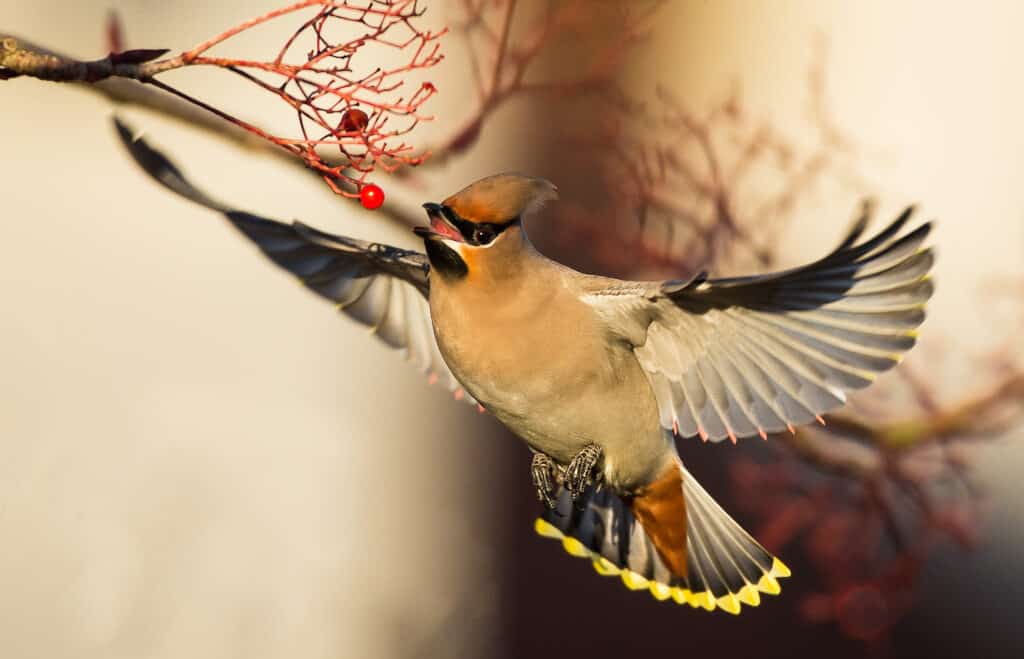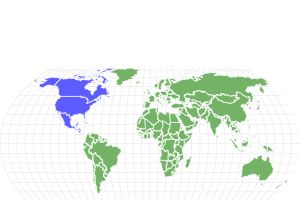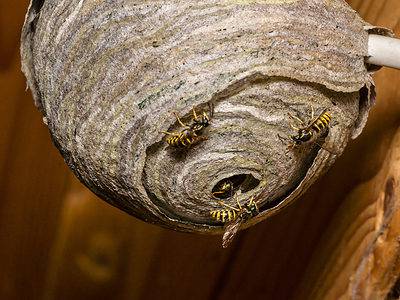Cedar Waxwing
Bombycilla cedrorum
Their feathers have red, waxy tips that can be hard to identify unless you’re up close.
Advertisement
Cedar Waxwing Scientific Classification
- Kingdom
- Animalia
- Phylum
- Chordata
- Class
- Aves
- Order
- Passeriformes
- Family
- Bombycillidae
- Genus
- Bombycilla
- Scientific Name
- Bombycilla cedrorum
Read our Complete Guide to Classification of Animals.
Cedar Waxwing Conservation Status
Cedar Waxwing Facts
- Prey
- berries, small fruit, flowers, oozing sap, and insects.
- Name Of Young
- Chicks
- Group Behavior
- Social
- Fun Fact
- Their feathers have red, waxy tips that can be hard to identify unless you’re up close.
- Estimated Population Size
- 64 million
- Biggest Threat
- Collisions with cars and windows
- Most Distinctive Feature
- Rotund bodies and flat crests
- Distinctive Feature
- Large heads, short bills
- Wingspan
- 8.7 to 11.8 inches
- Incubation Period
- 12 to 13 days
- Age Of Fledgling
- 14 to 18 days
- Habitat
- Open woodlands with fruiting trees
- Predators
- merlins, hawks, grackles, and bullfrogs.
- Diet
- Omnivore
- Lifestyle
- Diurnal
- Favorite Food
- Berries
- Type
- Bird
- Common Name
- Cedar waxwing
- Location
- North America
- Nesting Location
- Trees on a horizontal branch
- Migratory
- 1
View all of the Cedar Waxwing images!
“Their breeding habitats are solely chosen by the availability of fruiting trees and shrubs.”
Summary
The cedar waxwing (Bombycilla cedrorum) lives in North America and inhabits open areas with fruiting trees and shrubs. These birds are highly social and live in flocks year-round, often seen passing fruit to each other as they perch on branches. Listen for their high-pitched whistles as they fly over water or hover near berry bushes. Find out everything there is to know about this waxwing, including where it lives, what it eats, and how it behaves.
5 Amazing Cedar Waxwing Facts
- Their feathers have red, waxy tips that can be hard to identify unless you’re up close.
- Cedar waxwings are a social species, even nesting in small colonies.
- They are strong fliers and can reach up to 25 Mph.
- This species is serially monogamous, meaning they mate with one partner per breeding season.
- They have a large population, around 64 million, and their numbers are steadily increasing.
Where to Find the Cedar Waxwing
Cedar waxwings live in North America in 15 countries, including Canada, Mexico, The United States, Costa Rica, and the Bahamas. This species is migratory, spending its springs and summers in Southern Canada and its winters throughout the US, Mexico, and Central America. They inhabit open woodlands with abundant fruiting trees, like orchards, forest edges, streamsides, swamp edges, and backyards. Their breeding habitats are solely chosen by the availability of fruiting trees and shrubs.
Cedar Waxwing Nest
They place their nests in trees on a horizontal branch or fork, around six to twenty feet above the ground. Both sexes build a loosely constructed open cup of grass and twigs lined with moss, grass, and animal hair.
Scientific Name
The cedar waxwing (Bombycilla cedrorum) is from the Bombycillidae family, which includes the waxwings, three species of passerine birds. The genus name, Bombycilla, is Ancient Greek and Latin for “silk” and “tail.” And its specific name, Cedrorum, is Latin for “of the cedars.”
Size, Appearance, & Behavior

Cedar waxwings are short to long-distance migrants. They breed in Central to Southern Canada and spend winters in the Southern United States, Mexico, and Central America.
©Paul Tymon/Shutterstock.com
The cedar waxwing is a medium-sized passerine bird, measuring six to seven inches long and weighing 1.1 ounces, with an 8.7 to 11.8-inch wingspan. They have rotund bodies with large heads and broad, short bills. They have short tails and wide, pointed wings, and their crest is flat and lays over the back of their head. It has a light brown head and chest, a yellow belly, gray wings, and a black face mask outlined in white. Its tail is also gray with yellow tips, and its wings have red, waxy tips on the end of the feathers.
These are highly social birds who stay in flocks year-round and will even nest in small communities. They are solid, steady fliers with constant wing beats reaching 25 Mph. It often calls, especially in flight. Their calls sound like high-pitched whistles and buzzy trills. They flutter around berry branches, passing fruit to one another.
Migration Pattern and Timing
Cedar waxwings are short to long-distance migrants. They breed in Central to Southern Canada and spend winters in the Southern United States, Mexico, and Central America. Some populations in the northern half of the United States live year-round in their environments.
Diet
Cedar waxwings are omnivores who forage in flocks.
What Does the Cedar Waxwing Eat?
Their diet includes berries, small fruit, flowers, oozing sap, and insects. They feed on various berries like wild cherries and juniper and consume insects like beetles, ants, and caterpillars. These birds forage alone or in pairs during the nesting season but eat in flocks the rest of the year. They hover over vegetation to take berries and insects, and they will catch flying insects mid-air.
Predators, Threats, and Conservation Status
The IUCN lists the cedar waxwing as LC or “least concern.” Due to its extensive range and extremely large, increasing population, this species does not meet the “threatened” status criteria. The most significant threat to the cedar waxwing is collisions with cars and windows. They could potentially be affected by climate change in the future and suffer from spring heat waves and wildfires.
What Eats the Cedar Waxwing?
Cedar waxwing predators include merlins, hawks, grackles, and bullfrogs. Blue jays and house wrens are their nest predators. Not much is known about how these birds defend themselves, but they may find safety in numbers.
Reproduction, Young, and Molting
Cedar waxwings are serially monogamous, meaning they mate with only one partner per breeding season. Their courtship displays include posturing, touching bills, and passing food back and forth. Their nesting season is late and doesn’t begin until mid-summer, and they lay two broods per year. Females lay two to six, typically three to five, pale blue-gray eggs with brown and black spots. Females incubate for 12 to 13 days, but both parents assist in feeding the nestlings. The young fledge the nest 14 to 18 days after hatching and can reproduce around one year old. This species can live up to eight years in the wild.
Population
The global cedar waxwing population is estimated to number 64 million mature individuals. Trends suggest their numbers increased over 7% in the last ten years and continue to increase slowly. Their numbers are not experiencing any extreme fluctuations or fragmentations.
Similar Animals:
View all 235 animals that start with CCedar Waxwing FAQs (Frequently Asked Questions)
Where does the cedar waxwing live?
Cedar waxwings live in North America in 15 countries, including Canada, Mexico, The United States, Costa Rica, and the Bahamas.
How big is a cedar waxwing?
The cedar waxwing is a medium-sized passerine bird, measuring six to seven inches long and weighing 1.1 ounces, with an 8.7 to 11.8-inch wingspan.
What do cedar waxwings eat?
Their diet includes berries, small fruit, flowers, oozing sap, and insects. They feed on various berries like wild cherries and juniper and consume insects like beetles, ants, and caterpillars.
What threatens the cedar waxwing?
The most significant threat to the cedar waxwing is collisions with cars and windows. They could potentially be affected by climate change in the future and suffer from spring heat waves and wildfires.
What eats the cedar waxwing?
Cedar waxwing predators include merlins, hawks, grackles, and bullfrogs.
How many eggs does the cedar waxwing lay?
Females lay two to six, typically three to five, pale blue-gray eggs with brown and black spots.
What does the cedar waxwing sound like?
It often calls, especially in flight. Their calls sound like high-pitched whistles and buzzy trills.
Thank you for reading! Have some feedback for us? Contact the AZ Animals editorial team.

















